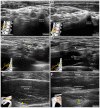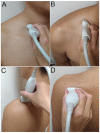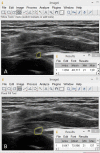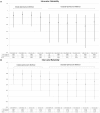Basis of Shoulder Nerve Entrapment Syndrome: An Ultrasonographic Study Exploring Factors Influencing Cross-Sectional Area of the Suprascapular Nerve
- PMID: 30405524
- PMCID: PMC6205983
- DOI: 10.3389/fneur.2018.00902
Basis of Shoulder Nerve Entrapment Syndrome: An Ultrasonographic Study Exploring Factors Influencing Cross-Sectional Area of the Suprascapular Nerve
Abstract
As changes in nerves' shape and size are common ultrasonographic findings of entrapment neuropathy, measurement of the nerve cross-sectional area (CSA) becomes the mostly used indicator to differentiate normality from pathology. Recently, more US research has been conducted to measure the shape of the suprascapular notch and the diameter of the suprascapular nerve. Because the suprascapular nerve is paramount for various shoulder disorders, the present study aims to establish normal values of suprascapular nerve sizes at different levels as well as to investigate potential influence of participants' characteristics on the CSA measurements. The present study used a cross-sectional design investigating the CSA values of the suprascapular nerve from the supraclavicular region to spinoglenoid notch. We employed the inside-epineurium and outside-epineurium methods to quantify CSA of cervical roots (C5 and C6) and the suprascapular nerve on US imaging. Univariate comparisons of nerve sizes among different age and gender groups were carried out. Multivariate analysis was performed to analyze the impact of participants' characteristics on nerve CSA. Repeated measurement analysis of variance was conducted to examine segmental variations of CSA of the suprascapular nerve from its origin to infraspinatus fossa. Our study included 60 healthy adults with 120 shoulders and had three major findings: (1) the inside-epineurium method was more reliable than the outside-epineurium approach for CSA measurements due to higher intra- and inter-rater reliability, (2) women had smaller sizes for cervical nerve roots and for the most proximal segment of the suprascapular nerves, and (3) using the outside-epineurium method, the suprascapular nerve CSA was larger in its distal division than the portion proximal to the mid-clavicular line. In conclusion, the inside-epineurium method has better reliability for nerve CSA assessment but the outside-epineurium method is needed for quantifying the size of distal suprascapular nerve. Gender difference in CSA values should be considered during evaluation of the most proximal nerve segment. Using the outside-epineurium method, the distal suprascapular nerve would be estimated larger than its proximal portion and the segmental discrepancy should be not misinterpreted as pathology.
Keywords: cervical root; entrapment neuropathy; shoulder pain; sonography; suprascapular nerve.
Figures







Similar articles
-
Suprascapular Nerve Entrapment Caused by Protrusion of an Intraosseous Ganglion of the Glenoid into the Spinoglenoid Notch: A Rare Cause of Posterior Shoulder Pain.Case Rep Orthop. 2017;2017:1704697. doi: 10.1155/2017/1704697. Epub 2017 May 23. Case Rep Orthop. 2017. PMID: 28620557 Free PMC article.
-
Direct Hemi-Hypoglossal Nerve and Hypoglossal Nerve for Suprascapular Nerve/Proximal Brachial Plexus Neurotization: A Cadaveric Feasibility Study.Cureus. 2023 Mar 21;15(3):e36472. doi: 10.7759/cureus.36472. eCollection 2023 Mar. Cureus. 2023. PMID: 37090292 Free PMC article.
-
MRI diagnosis of suprascapular neuropathy using spinoglenoid notch distension.Radiol Med. 2019 Jul;124(7):643-652. doi: 10.1007/s11547-019-01005-z. Epub 2019 Mar 5. Radiol Med. 2019. PMID: 30835024
-
Cross-sectional area reference values for peripheral nerve ultrasound in adults: A systematic review and meta-analysis-Part III: Cervical nerve roots and vagal nerve.Eur J Neurol. 2021 Jul;28(7):2319-2326. doi: 10.1111/ene.14862. Epub 2021 May 2. Eur J Neurol. 2021. PMID: 33838065
-
Protective and Predisposing Morphological Factors in Suprascapular Nerve Entrapment Syndrome: A Fundamental Review Based on Recent Observations.Biomed Res Int. 2017;2017:4659761. doi: 10.1155/2017/4659761. Epub 2017 Jun 13. Biomed Res Int. 2017. PMID: 28691025 Free PMC article. Review.
Cited by
-
Enhancing diagnosis and treatment of superior cluneal nerve entrapment: cadaveric, clinical, and ultrasonographic insights.Insights Imaging. 2023 Jul 3;14(1):116. doi: 10.1186/s13244-023-01463-0. Insights Imaging. 2023. PMID: 37395948 Free PMC article.
-
Prognostic Value of Ultrasonography in Predicting Therapeutic Outcome for Carpal Tunnel Syndrome after Conservative Treatment: A Retrospective Long-term Follow-up Study.J Med Ultrasound. 2019 May 13;27(4):192-197. doi: 10.4103/JMU.JMU_13_19. eCollection 2019 Oct-Dec. J Med Ultrasound. 2019. PMID: 31867193 Free PMC article.
-
Solitary Calcified Nodules as the Cause of Carpal Tunnel Syndrome: Two Case Reports and Literature Reviews.Front Neurol. 2019 Mar 15;10:224. doi: 10.3389/fneur.2019.00224. eCollection 2019. Front Neurol. 2019. PMID: 30930838 Free PMC article.
-
High-energy focused extracorporeal shock wave therapy for bone marrow edema syndrome of the hip: A retrospective study.Medicine (Baltimore). 2020 Apr;99(16):e19747. doi: 10.1097/MD.0000000000019747. Medicine (Baltimore). 2020. PMID: 32311970 Free PMC article.
-
The Effect of Extracorporeal Shock Wave Therapy in the Treatment of Patients with Trigger Finger.Open Access J Sports Med. 2020 Mar 9;11:85-91. doi: 10.2147/OAJSM.S232727. eCollection 2020. Open Access J Sports Med. 2020. PMID: 32210646 Free PMC article.
References
LinkOut - more resources
Full Text Sources
Research Materials
Miscellaneous

